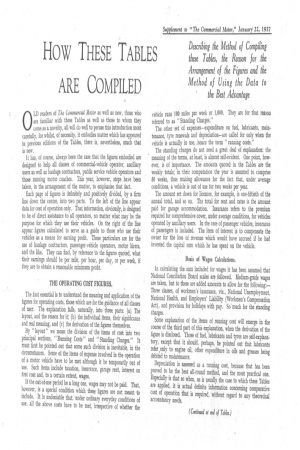HOW THESE TABLES ARE COMPILED
Page 110

If you've noticed an error in this article please click here to report it so we can fix it.
0 LD readers of The Commercial Motor as well as new, those who are familiar with these Tables as well as those to whom they come as a novelty, all will do well to peruse this introduction most carefully, for whilst, of necessity, it embodies matter which has appeared in previous editions of the Tables, there is, nevertheless, much that is new.
It has, of course, always been the case that the figures embodied are designed to help all classes of commercial-vehicle operator, ancillary users as well as haulage contractors, public service vehicle operators and those running motor coaches. This year, however, steps have been taken, in the arrangement of the matter, to emphasize that fact.
Each page of figures is definitely and positively divided, by a firm line down the centre, into two parts. To the left of the line appear data for cost of operation only. That information, obviously, is designed to be of direct assistance to all operators, no matter what may be the purpose for which they use their vehicles. On the right of the line appear figures calculated to serve as a guide to those who use their vehicles as a means for earning profit. These particulars are for the use of haulage contractors, passenger-vehicle operators, motor hirers, and the like. They can find, by reference to the figures quoted, what their earnings should be per mile, per hour, per day, or per week, if they are to obtain a reasonable minimum profit.
THE OPERATING COST FIGURES.
The first essential is to understand the meaning and application of the figures for operating costs, those which are for the guidance of all classes of user. The explanation falls, naturally, into three parts: (a) The layout, and the reason for it; (b) the individual items, their significance and real meaning, and (c) the derivation of the figures themselves.
By " layout " we mean the division of the items of cost into two principal sections, "Running Costs" and "Standing Charges." It must first be pointed out that some such division is inevitable, in the circumstances. Some of the items of expense involved in the operation of a motor vehicle have to be met although it be temporarily out of use. Such items include taxation, insurance, garage rent, interest on first cost and, to a certain extent, wages. If the out-of-use period be a long one, wages may not be paid. That, however, is a special condition which these figures are not meant to include. It is undeniable that, under ordinary everyday conditions of use, all the above costs have to be met, irrespective of whether the vehicle runs 100 miles per week or 1,000. They are for that reason referred to as "Standing Charges."
The other set of expenses—expenditure on fuel, lubricants, maintenance, tyre renewals and depreciation--are called for only when the vehicle is actually in use, hence the term "running costs."
The standing charges do not need a great deal of explanation: the meaning of the terms, at least, is almost self-evident. One point, however, is of importance. The amounts quoted in the Tables are the weekly totals; in their computation the year is assumed to comprise 50 weeks, thus making allowance for the fact that, under average conditions, a vehicle is out of use for two weeks per year.
The amount set down for licences, for example, is one-fiftieth of the annual total, and so on. The total for rent and rates is the amount paid for garage accommodation. Insurance refers to the premium required for comprehensive cover, under average conditions, for vehicles operated by ancillary users. In the case of passenger vehicles, insurance of passengers is included. The item of interest is to compensate the owner for the loss oi revenue which would have accrued if he had invested the capital sum which he has spent on the vehicle.
Basis of Wages Calculations.
In calculating the sum included for wages it has been assumed that National Conciliation Board scales are followed. Medium-grade wages are taken, but to these are added amounts to allow for the following:— Three classes, of workmen's insurance, viz., National Unemployment, National Health, and Employers' Liability (Workmen's Compensation Act), and provision for holidays with pay. So -much for the standing charges.
Some explanation of the items of running cost will emerge in the course of the third part of this explanation, when the derivation of the figure is disclosed. Those of fuel, lubricants and tyres are self-explanatory, except that it should, perhaps, be pointed out that lubricants refer ,only to engine oil, other expenditure in oils and greases being debited to maintenance.
Depreciation is assessed as a running cost, because that has been proved to be the best all-round method, and the most practical one. Especially is that so when, as is usually the case to which these Tables are applied, it is actual definite information concerning comparative cost of operation that is required, without regard to any theoretical accountancy needs.
















































































































